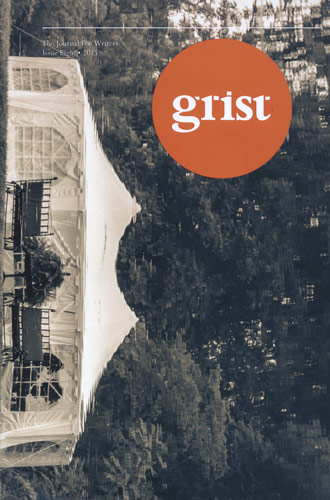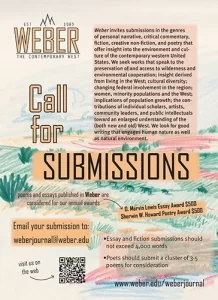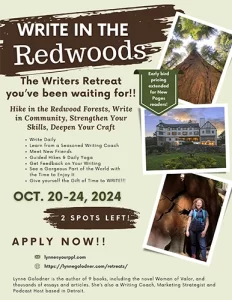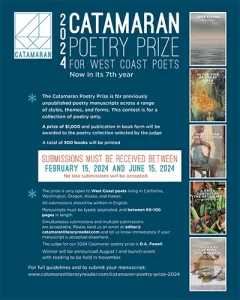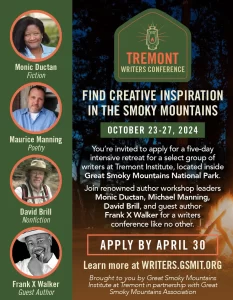Grist – 2015
Grist is an annual magazine published in paperback by the University of Tennessee at Knoxville. Subtitled “the journal for writers,” the masthead says that Grist is “devoted to contemporary literary art and essays that present and represent the writer’s occupation.” The operation is run by students, so the accent is on “contemporary.” Grist is an annual magazine published in paperback by the University of Tennessee at Knoxville. Subtitled “the journal for writers,” the masthead says that Grist is “devoted to contemporary literary art and essays that present and represent the writer’s occupation.” The operation is run by students, so the accent is on “contemporary.”
There are forty-one poems, three each of fiction and nonfiction, two craft essays, and two pieces labeled as interviews. The table of contents also lists about ten more pieces in an “Online Companion,” via the journal’s website. These poems and fiction are published online only, replacing Grist’s previous Emerging Writers feature.
In the print version: “Letter for the Musician” by Jim Whiteside is a 61-line poem in the traditional form of a verse letter. Whiteside states the theme: it is difficult to find language for emotion. The poem has dialogue in italics between the writer and “you,” as well as a third character, “a friend who is inventing his own / language.” The end returns to the image expressed in the opening lines: “On the morning after the ice storm, I saw /
a truck with its bed full of carousel horses.”
After this strong start, “Injured Party” by Andrea Cohen, is a pun on the word “party,” meaning both a person and a social gathering with funny hats, sprinklers and sirens. “Fire Escape” by Leslie Anne Mcilroy takes place at the same party, it seems, as two people drink scotch and smoke outdoors on a fire escape. “Your eyes all flame” stand for the heat of passion, and at the end “there’s no escaping this.”
In general, the poems present images with little interpretation. In Carolyn Williams-Noren’s brief “Iris Feeds a Sheep,” a little girl feeds grass to “the malt-haired sheep” while her mother watches and takes photos. In L.S. McKee’s five-part poem “Wing,” she alludes to the myth of Icarus and a boy who jumped off a dam. In “Runner,” Benjamin Schmitt pairs the image of a runner in headphones with the
planet
burnt to the core,
Mercury in its track around the sun
wearing winged shoes.
Poems by Anders Carlson-Wee stand out from the rest. His “Bald Eagle,” a somewhat macabre poem in which a woman gathers material for a necklace, begins “She knows she wants the skull, the wings, / the white feathers, and the feet.”
“Cavalier Presentations of Heartbreaking News” buries a good story in its eight pages, though Sadie Hoagland does not quite dig it out. Riley Kross contributes his first published story about a séance scam and a man who sets fire to the building. Jon Gingerich writes “The Vest,” in which a man enters a construction site, puts on a discarded safety vest, does aimless things and overhears bits of dialogue—a little lacking from what I’d expected.
Darius Stewart’s interview with the poet of color Camille Rankine is professional and to the point. But the effort by two Grist editors titled “A Conversation with Sandra Alcosser” is not. Alcosser, the first poet laureate of Montana, “founded and directs San Diego State University’s MFA each fall.” She evades the first question in more than a page which includes the sentence: “We’re meaning-making animals.” She quotes Richard Hugo and Mark Doty at length, and she mentions a dozen other writers, coming across as an academic magpie, not as an award-winning poet of nature.
The nonfiction and craft essays are the issue’s strong suit. Stephanie Wortman looks long and hard at a 1959 painting, Larry Rivers’ Drugstore. Fabienne Josaphat remembers a childhood summer in Haiti, watching adults in love: “My parents’ marriage was broken long before the 1986 coup d’état shattered their lives.” Kathryn Davis in “Time Passes” meditates on Virginia Woolf’s novel To the Lighthouse, and the mysterious way we experience time in our lives. Michael Leong makes a case for the way a poem is printed, “the graphic look of the page,” as being indispensable to its meaning.
If the quality in this issue is uneven, the selection is broad. Whether you are a writer or a reader, you will find something to like in Grist.
[www.gristjournal.com]

